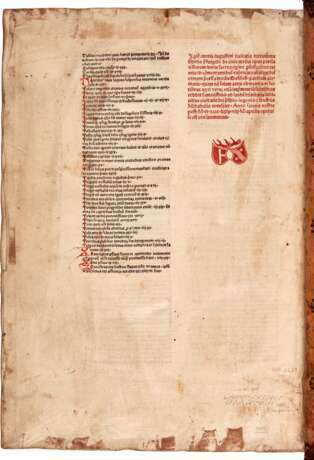ID 1073283
Lot 5 | Aurelius Augustinus | De civitate Dei. Basel, 25 March 1479, contemporary binding
Valeur estimée
£ 6 000 – 8 000
De civitate Dei. Basel: Michael Wenssler [and Bernhard Richel], 25 March 1479
Third edition with this commentary by Thomas Waleys and Nicolaus Trivet, Royal folio (498 x 335mm.), 247 leaves (of 248, without initial blank), double-column, 56 lines of text, 73 lines of commentary, gothic type, printed in red and black, red capital strokes, paragraph marks and headlines written in red ink, numerous one- to eight-line initials in red, contemporary German blind-stamped calf over wooden boards, boards with two frames featuring lily, stag, and rosette tools enclosing a central panel divided by diagonal rules into quadrants decorated with stag, hound, rose, lily, and rosette stamps, contemporary vellum title label lettered in red and black at head of upper board, spine panels with central lily stamp surrounded by rosettes, brass corner guards, original brass catch plates and clasps, rear board with remnants of paper manuscript pastedown and the wood retaining traces of its ink writing in red and black, [278] bound after [276], first and last pages somewhat soiled, the former also with faint brown stain (apparently from fixative used to stabilize the paint used here for rubrication) running down the centre of the leaf (not affecting legibility), joints worn, with bands exposed where they meet the spine, straps renewed, rear board with leather patch where chain attachment once was, inner covers with wooden boards and cords exposed
This is a handsome early Basel printing of St Augustine’s celebrated City of God. First issued by Sweynheym and Pannartz in 1467, the work takes its name from the author’s characterization of all history as the struggle between the City of God (i.e., good, personified by devout Christians) and the Earthly City (evil, personified by pagans and other non-believers), the conflict to be resolved on Judgment Day, when the residents of the City of God will be granted immortal life, and their foes will be damned for eternity. Begun shortly after the sack of Rome in 410 and occupying some 13 years in composition, De civitate Dei is Augustine’s longest and perhaps most influential work. It is remarkable in its elaborate structure and wide ranging in the strategies and fields of inquiry it employs in the name of Christian vindication, with appeals drawn from cosmology, psychology, political thought, theory of history, and much more.
The present printing is the third edition with this commentary, and is taller than those issued by Mentelin (not after 1468) and Schoeffer (1473). The commentary is by two respected Dominican scholars from Oxford: the erudite classicist Nicholas Trevet [Trivet] (ca. 1257 - after 1334) wrote the commentary for books 11–22, and theologian Thomas Waleys (fl. 1318-49) did that for books 1-10. In this edition, the commentary is printed following the main text, rather than surrounding it, as in later versions. Wenssler was apparently assisted in this project by fellow Basel printer Bernhard Richel, as the 10th quire and the first few leaves of the 11th quire are printed in one of Richel’s types. The fine, thick paper here, the attractive layout and vast margins, the rubrication, the solidly constructed binding—even the out-of- sequence arrangement of the penultimate quires—make this a wonderful exemplar of incunabular book production. The tools used on the binding do not appear in Kyriss or Schwenke-Sammlung, and could not be located in a search of EBDB. However, two are similar to Schwenke’s Hirsch 33 and Hund 42, assigned to Wolfgang Herolt of Erfurt; Lillie 282, used by a Leipzig bindery; and Lillie 333, found on bindings by a Würzburg workshop.
| Artiste: | Augustin d'Hippone (354 - 430) |
|---|---|
| Catégorie maison de vente aux enchères: | Impressions, graphiques, livres |
| Artiste: | Augustin d'Hippone (354 - 430) |
|---|---|
| Catégorie maison de vente aux enchères: | Impressions, graphiques, livres |
| Adresse de l'enchère |
Sotheby´s 34-35 New Bond Street W1A 2AA London Royaume-Uni | |
|---|---|---|
| Aperçu |
| |
| Téléphone | +44 (0) 20 7293 5000 | |
| Téléphone | +1 212 606 7000 | |
| Conditions d'utilisation | Conditions d'utilisation |





